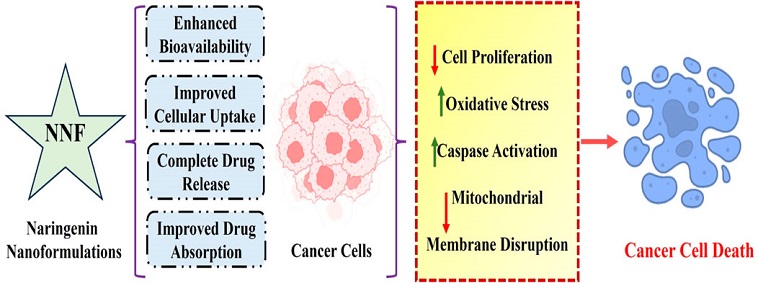Nikhil Prasad Fact checked by:Thailand Medical News Team Jun 19, 2024 1 year, 3 months, 4 weeks, 4 hours, 21 minutes ago
Breast Cancer News: Naringenin, a natural compound found in citrus fruits like oranges and grapefruits, is showing promising potential in the fight against breast cancer. Scientists have discovered that this potent antioxidant can slow down cancer progression and improve the health of patients. But how does it work, and what makes it so special? A new study by researchers from Rabdan Academy-UAE, Chitkara University-India, Chandigarh University-India, Lovely Professional University-India, King Khalid University-Saudi Arabia, University of Ha’il-Saudi Arabia, Uttaranchal University-India and Saveetha Institute of Medical and Technical Sciences-India that is covered in this
Breast Cancer News report, delves into the fascinating world of naringenin and its role in cancer therapy.
 Naringenin-Breast-Cancer
Naringenin-Breast-Cancer
Molecular mechanisms of naringenin-based nanoformulations against breast cancer. Overall, these results highlight the enormous potential of innovative naringenin nanoformulations as effective medical delivery methods for breast cancer treatment and imply that naringeninencapsulated nanoparticles are more potent in breast cancer therapy than the solely given phytochemical agent.
The Power of Naringenin
Naringenin is a bioactive compound known for its multiple health benefits, including anti-inflammatory, antioxidant, neuroprotective, and anti-cancer activities. Recent studies have shown that naringenin can inhibit cancer cell growth and promote cell death in various types of cancer, including breast cancer. By affecting key processes like cell cycle regulation, inflammation, and apoptosis (programmed cell death), naringenin can effectively suppress cancer progression.
How Naringenin Works
Naringenin works through several mechanisms to combat cancer:
-Antioxidant Effects: Naringenin helps reduce oxidative stress, a condition that can lead to cancer development. By scavenging harmful free radicals, it protects cells from damage.
-Cell Cycle Arrest: It can stop cancer cells from multiplying by causing cell cycle arrest, particularly in the G0/G1 phase. This means cancer cells are unable to proceed to the next stage of growth and division.
-Apoptosis Induction: Naringenin promotes apoptosis, a natural process where damaged or unwanted cells are programmed to die. This helps eliminate cancer cells.
-Anti-inflammatory Actions: Chronic inflammation is a known risk factor for cancer. Naringenin's anti-inflammatory properties can reduce this risk by lowering the levels of pro-inflammatory cytokines and other markers.
-Inhibition of Metastasis: Naringenin has been shown to prevent cancer cells from spreading to other parts of the body, which is crucial in managing breast cancer.
&
lt;strong>Nanoformulations: Enhancing Naringenin's Efficacy
One of the challenges with naringenin is its low bioavailability, meaning that it's not easily absorbed by the body when taken orally. Researchers have developed nanoformulations to overcome this issue. These tiny particles can enhance the delivery and absorption of naringenin, making it more effective.
Nanoformulations also allow for targeted delivery to cancer cells, reducing potential side effects on healthy tissues.
Combining Naringenin with Other Treatments
Naringenin's potential is further amplified when combined with other cancer treatments. For example, studies have shown that combining naringenin with tamoxifen, a commonly used breast cancer drug, can improve treatment outcomes. This combination can reduce the proliferation of cancer cells more effectively than either treatment alone.
Research Findings
Research involving cell lines and animal models has demonstrated the significant anticancer potential of naringenin. Here are some key findings:
-Breast Cancer Cells: Naringenin has been shown to inhibit the growth of breast cancer cells and induce apoptosis. It also reduces the ability of these cells to migrate and invade other tissues.
-Animal Studies: In animal models, naringenin has reduced tumor size and metastasis, leading to improved survival rates.
-Combination Therapy: Studies combining naringenin with other anticancer agents have reported enhanced efficacy, suggesting that naringenin can act as a chemosensitizer, making cancer cells more susceptible to treatment.
Future Prospects
While the research on naringenin is promising, more studies, especially clinical trials in humans, are needed to fully understand its potential and safety. The development of effective nanoformulations and combination therapies could pave the way for naringenin to become a standard part of cancer treatment protocols.
Conclusion: A Bright Future for Naringenin
Naringenin, a humble compound from citrus fruits, is emerging as a powerful player in the fight against breast cancer. Its ability to inhibit cancer growth, promote cell death, and enhance the efficacy of existing treatments makes it a promising candidate for future therapies. As research progresses, naringenin could become a vital component in the arsenal against cancer, offering hope to patients and healthcare providers alike.
The study findings were published in the peer reviewed journal: Frontiers in Pharmacology.
https://www.frontiersin.org/journals/pharmacology/articles/10.3389/fphar.2024.1406619/full
For the latest
Breast Cancer News, keep on logging to Thailand Medical News.
Read Also:
https://www.thailandmedical.news/news/new-hope-in-the-fight-against-breast-cancer-introducing-p18-the-super-peptide
https://www.thailandmedical.news/news/herbs-and-phytochemicals-halodule-uninervis-a-new-hope-in-breast-cancer-treatment
https://www.thailandmedical.news/news/new-discovery-mouse-mammary-tumour-virus-mmtv-linked-to-human-breast-cancer
https://www.thailandmedical.news/news/covid-19-s-effect-on-breast-cancer-cells
